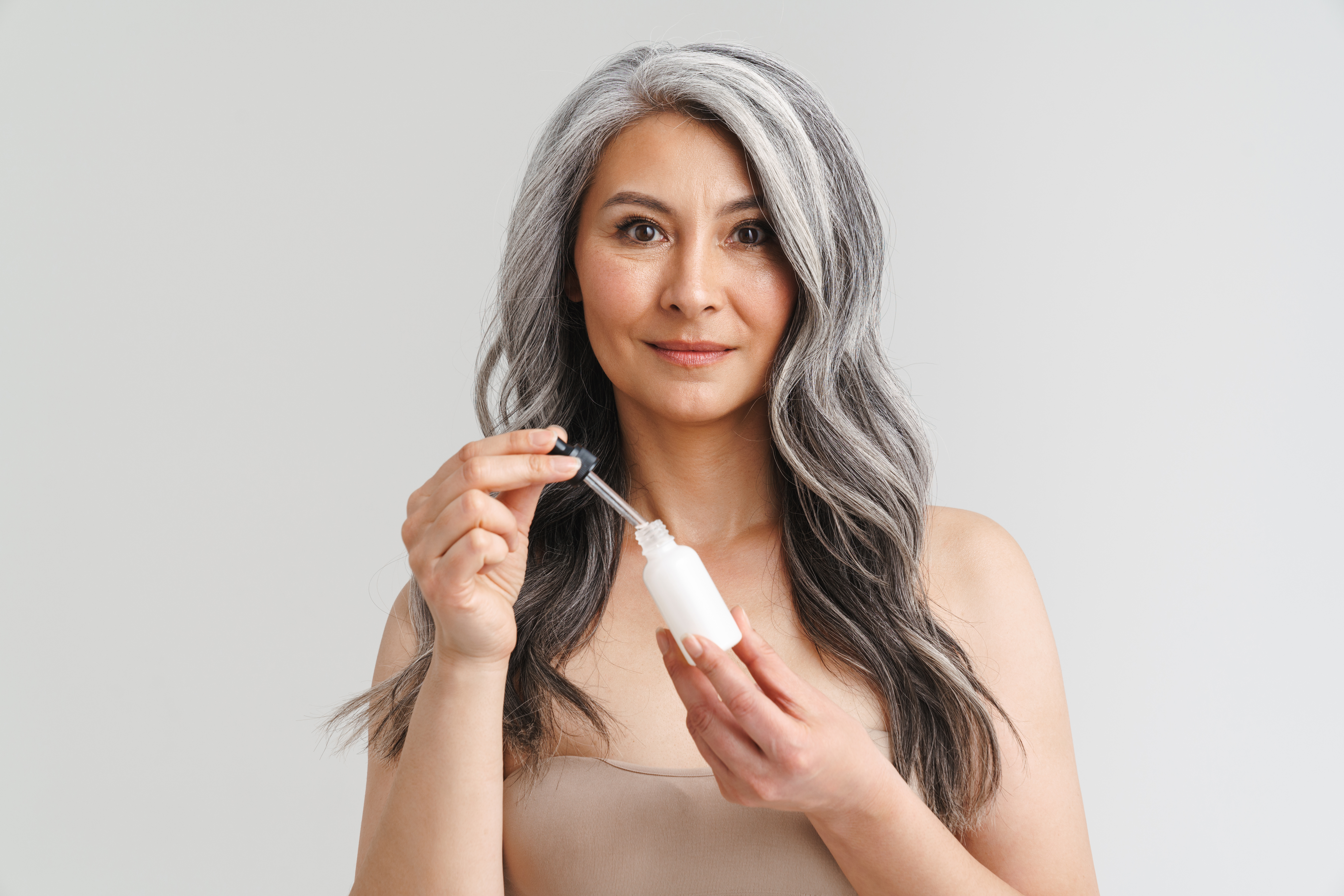
The beauty industry is in the midst of an explosive growth cycle, even during the pandemic. How big is the beauty industry? Up from $483B in 2020 to $511B in 2021 — and with an annual compounded growth rate of 4.75% worldwide — it’s predicted to exceed $716B by 2025.
Where is the growth coming from? A lot of it is skin care. Skincare made up 42% of the global cosmetic market in 2020. It follows that this trend will continue as consumers become more educated about sun damage — indicating potential for growth within the subcategories of sun protection and anti-aging skincare products.
Drilling down even more, a good portion of growth in the skin care market is coming from facial serums, which is expected to grow by $261.38M from 2020 to 2025. The reason is growing demand for effective products that can target specific skincare problems such as acne, skin brightening, aging, and wrinkles. The high moisturizing property of the face serum is attracting customers, particularly middle-aged people who wish to maintain a more youthful appearance.
Thus it makes sense that demand increased during the pandemic due to the up-close-and-personal nature of Zoom calls or video communication, which can highlight skin imperfections.

INCREASED NEED FOR LIQUID DISPENSING
With the growth of facial serums and even hair care oils, there has been a “very liquid formula” trend in the skincare and hair care markets in the past few years. This is leading to beauty products manufacturers to look at new packaging options for their liquid products. To help beauty manufacturers, who are potentially new to liquid formulas for their products, we want to help you make the important decision on the right primary packaging options that will create a positive customer experience.
Liquids can be messy, so quality packaging materials and a quality filling process are going to be important. You’ll need to select the proper packaging products (bottle, caps, pipettes, sprayers, pumps) as well as the proper capping setup. It’s important that your serums, tinctures, or oil drops, pour, or spray as desired, and purchasers become repeat customers.
The ingredients in your formulas could play a factor in choosing the right packaging solutions. Many ingredients in beauty products are air-sensitive like retinol, peptides, and vitamin C. Natural, green skincare products are full of great ingredients like essential oils, fatty acids, natural surfactants, and fruit acids, all of which can react badly to some types of material.
At Carow Packaging, we carry the most popular dispensing solutions beauty manufacturers need to control the quality of their product. Here’s a primer on what packaging products you may need to consider for dispensing your facial serums or hair oils.
PLASTIC OR GLASS BOTTLES
While jars are common for many thicker beauty products, they are not the best containers for many ingredients because every time you open the jar you expose the contents to air. Oxygen exposure can degrade the product formulation quickly. And, for thinner formulations, jars aren’t even an option.
 Bottles are the more practical container to use for liquid formulations, especially as they come in a variety of colors, neck sizes, overall sizes, and materials. One of the biggest decisions you need to make is plastic or glass.
Bottles are the more practical container to use for liquid formulations, especially as they come in a variety of colors, neck sizes, overall sizes, and materials. One of the biggest decisions you need to make is plastic or glass.
Plastic
Plastic bottles are widely available so they have become a common commodity in the beauty packaging business. They are compatible with either thick or thin liquids and they are also less likely to shatter, should they get dropped or banged around during shipping. Plastic bottles are also easily customized – from unique shapes that stand out on the shelf to a wider range of color options.
On the flip side, plastic bottles do not offer the same level of protection as glass against oxygen. This is an important determining factor in the shelf life of your product. In addition, selected aggressive oils and acids can interact with plastic which can lead to product contamination.
Glass
Glass on the other hand, offers different benefits and cautions. In the beauty industry, glass can be viewed as a more upscale material for packaging. In a March 2020 study of American preferences in packaging, 2,000 U.S. survey respondents chose glass first in the categories of reusability, look and feel, and better protection.
Unlike plastic, glass is inert. That means it has the durability and structural integrity to store liquids securely over time. Glass provides the best oxygen barrier, good for lengthening a product’s shelf life.
Glass is also less sensitive to light. Essential oils, serums and lotions that contain antioxidants (like vitamin C) and retinol should be packaged in dark, opaque bottles that block out UV light that can diminish their effectiveness over time. Amber colored glass bottles, a common choice for beauty products, block light wavelengths under 450 nm, which makes them ideal for light sensitive products.
Glass bottles are also very versatile, available in neck sizes to meet most any need. Liquid products vary in terms of viscosities. Thick or thin liquid formulations require dispensers with different orifice sizes. Glass bottles can accommodate a variety of dispensing types – sprayers, pumps, pipettes, and roller balls. To save money on packaging, you may be able to buy one bottle in larger quantities to take advantage of volume discounts, but change the dispensing mechanism to meet the viscosity and formulation needs of your products.
Finally, glass is also seen as an eco-friendly packaging option. Glass recycling can be repeated endlessly without damage to the end product. That makes glass a so-called permanent material, unlike plastic whose recycle life has limitations. Manufacturers can also appeal to their customers’ demands for sustainability by using glass bottles with high PCR (Post-Consumer Recycled) content. We offer bottles with the highest PCR content in the industry. You can read more about the benefits of PCR glass here.
Glass bottles, however, do have some drawbacks. First, glass can break so extra care needs to be taken with shipping and storing, as well as with consumer usage. Be cautious about glass containers for bath products as they can be broken in the tub and shower. Glass is also heavier than plastic so shipping costs will likely be higher.
Now that you have your container – your bottle – you’ll need a solution to dispense the right amount of product and provide for a good customer experience. Your dispensing solution options include dropper pipettes, pumps, sprayers, and EuroDrop® caps.
DROPPER PIPETTES
An eye dropper, also known as a Pasteur pipette, or dropper, is a device consisting of a small tube with a vacuum bulb that is used to transfer liquids one drop at a time.
For many of these serums, oil, and lotions, just a dab of the product is all that is needed, so manufacturers want to choose a solution that controls the amount of liquid being dispensed. Need control? You need dropper pipettes!
Droppers are great for skin care products that are patted into the skin using your fingertips - serums, face oils, and essences. They do not protect against air exposure as well as other dispensers, however, because each time you pull the pipette out, you let air into the bottle.
An added benefit of selecting a dropper pipette with an 18DIN neck finish is built-in tamper evidence. When the tamper evident band of the pipette cap slides over the transfer ring of a dropper bottle, no shrink wrapping is needed to ensure the product has not been opened.
Carow Packaging recently introduced the Super 10 program where the ten most common pipette styles are now stocked items, ensuring you get the packaging you need as quickly as possible.
You can read more about dropper pipettes in our complimentary Dropper Pipette Buyers Guide. You can also read more on how to choose between a glass or plastic pipette here.
SPRAYERS
A bottle with a sprayer is great for toners or really thin, watery liquid products, because you never touch and contaminate the product. You also don’t expose the product to air every day, so the product formulation doesn’t break down too quickly. Sprayers don’t offer much directional control though, so they are a good if you are looking to dispense the liquid over a larger area.
Typical components in a sprayer include:
PUMPS
Pumps are designed for easy dispensing in even, metered doses usually putting the product into your hand or onto your fingertips to then be applied to the desired area. Pumps are a good option for thicker liquids or liquids that need to be rubbed into the skin or hair as they are applied.

A pump is made up of a few components:
A pump acts much like an air suction device that draws the product from the bottle to the user's hand. When the user presses down on the actuator, the piston moves to compress the spring and the upward air pressure draws the ball upwards, along with the product into the dip tube and subsequently the housing chamber. As the user releases the actuator, the spring returns the piston and actuator into its up position, and the ball is returned to its resting position, sealing the chamber and preventing the liquid product from flowing back down into the bottle.

EURODROP® CAPS
Finally, the most accepted dispensing solution for precise, measured drops is the EuroDrop system. With one product orifice and one air orifice, the dropper insert uses hydro-static action to transfer product from the bottle. This improved drop dispensing technique provides an alternative to standard eye dropper pipettes. It works well for oil-based products.
But, to give your customers the best experience so they come back and buy more, you need to get the oil flow rate right. If the oil comes out too fast, the customer is irritated by wasted product or a messy experience. If the oil comes out too slow, the customer may assume that the product doesn’t work, or the dispenser is broken, leading to negative reviews online and no repeat business.
There are two types of dropper inserts for the EuroDrop cap, vertical or horizontal droppers.

In either case, the dropper will do the work, letting the pressure differential take place and air will go in as the drop falls out, with just the right amount of oil dispensing.
Regardless of which dropper insert your product uses, the flow rate for your essential oils should have these characteristics:
We have been helping customers find the perfect flow rate for over 30 years so rely on us to help you spec out the best dispensing solution for your beauty products. And, we are the only provider to make EuroDrop caps and inserts in the USA!
To learn more about EuroDrop dispensing system, read about how to get your oil, serum, or liquid flow rate right.
Want to learn more about the Carow Packaging difference and how we have the dispensing products beauty brands need to stand out and sell more? Give our Solution Specialists a call at 815-455-4600. We are happy to explain how we can customize, manufacture, and source unique product solutions to meet your liquid dispensing needs.

Marketing Manager

Get all the latest news and updates straight to your inbox